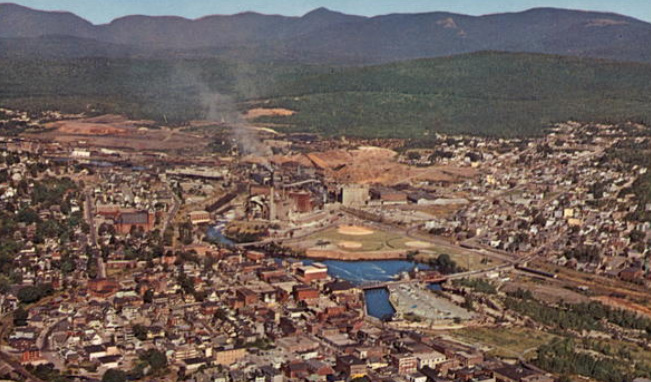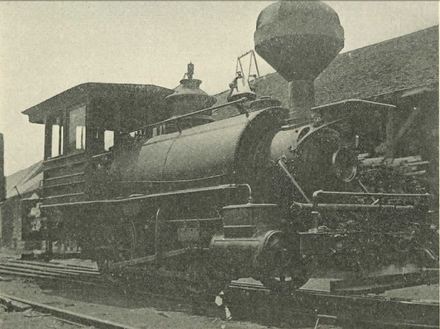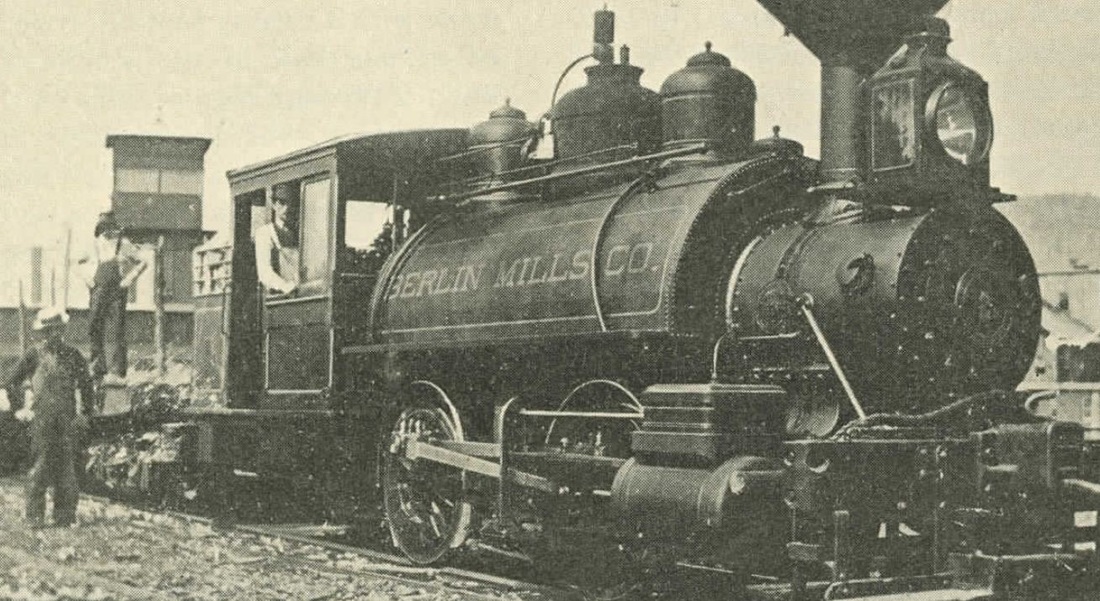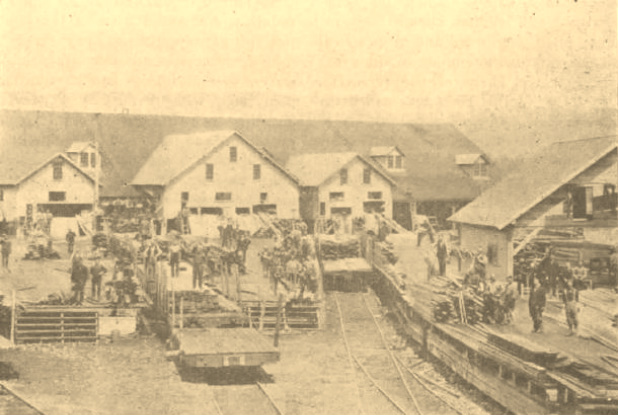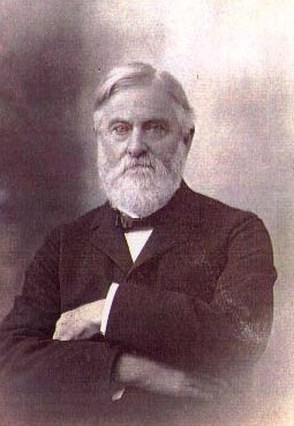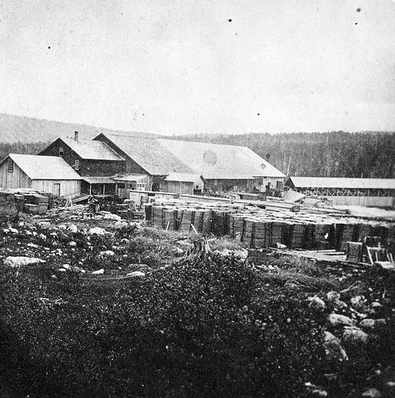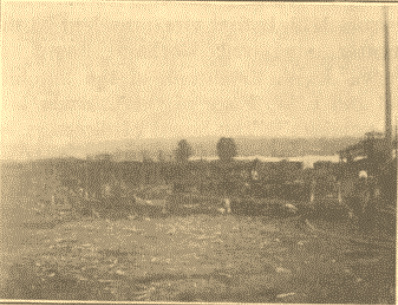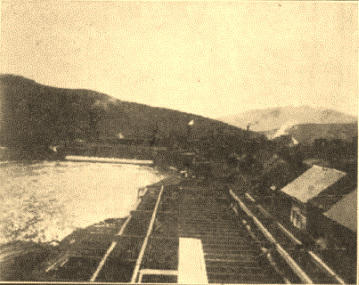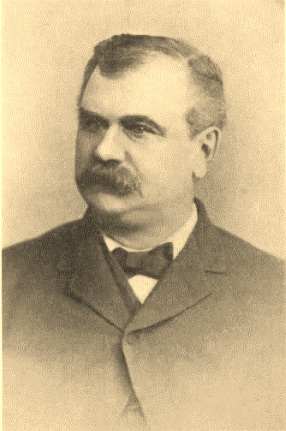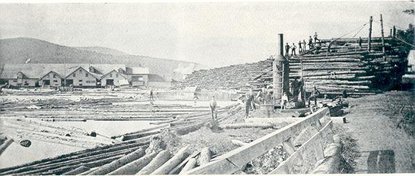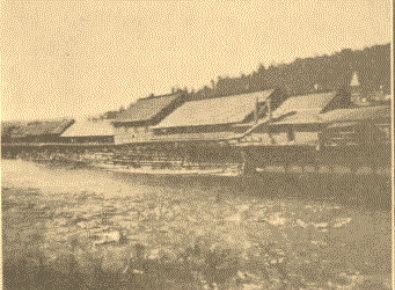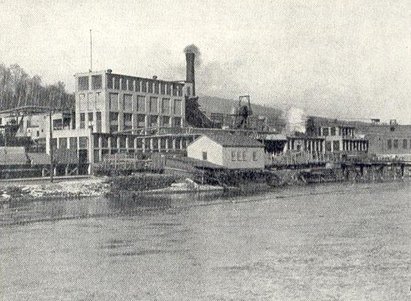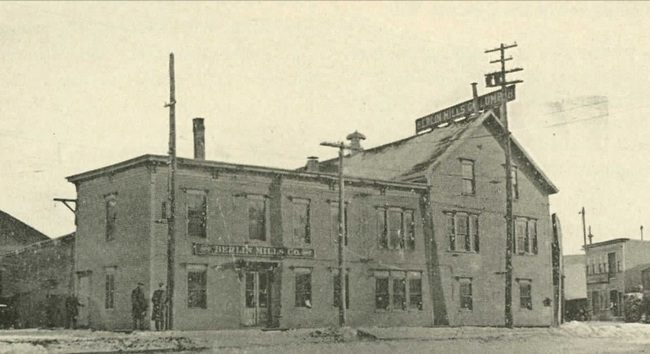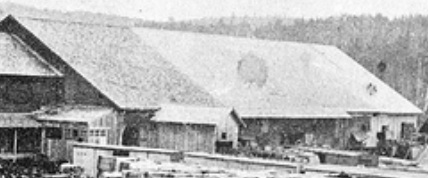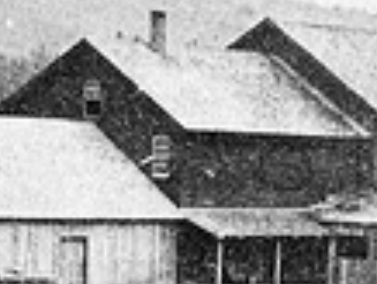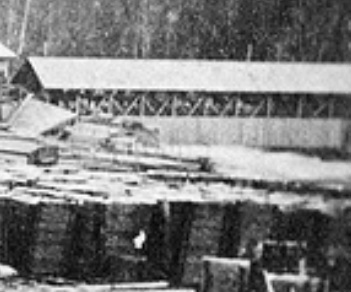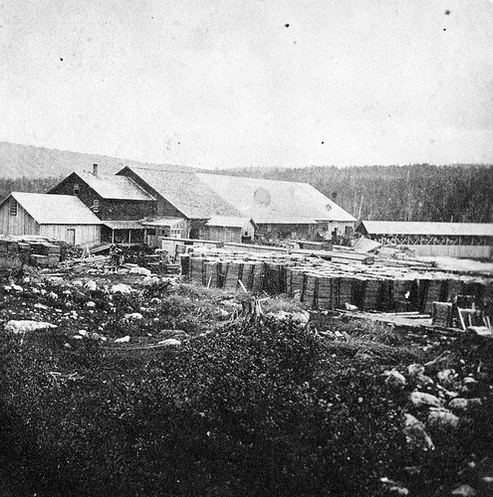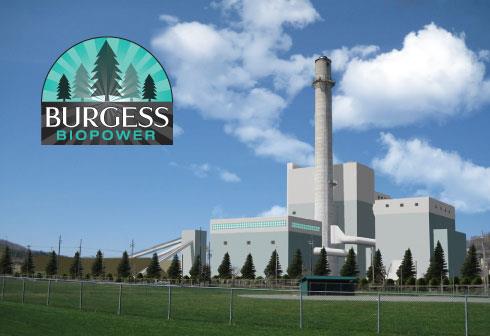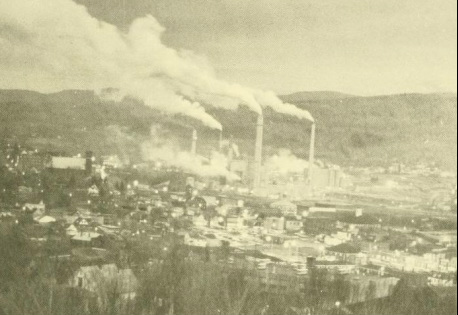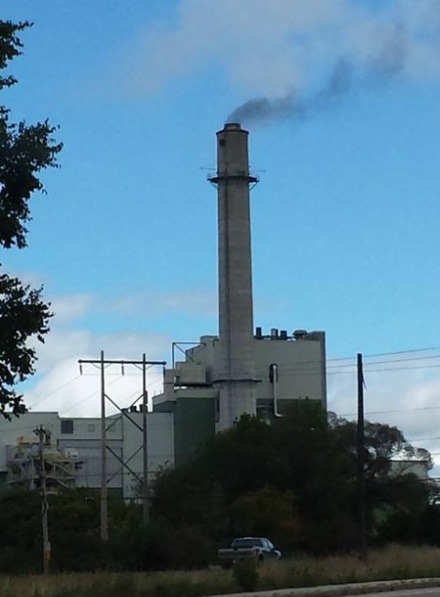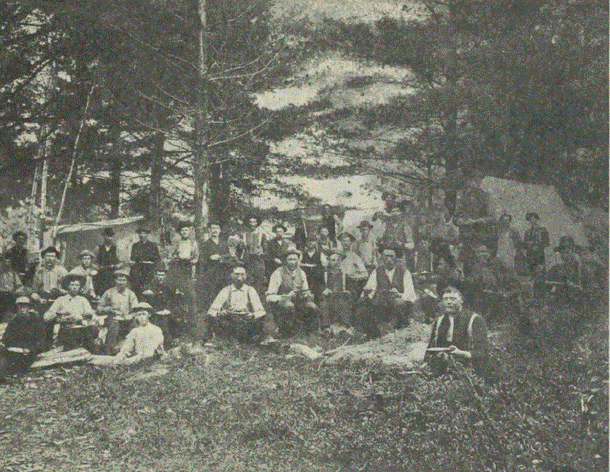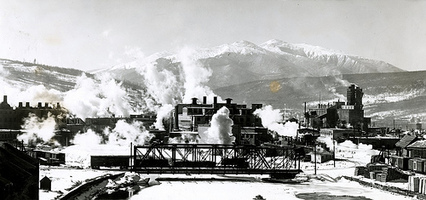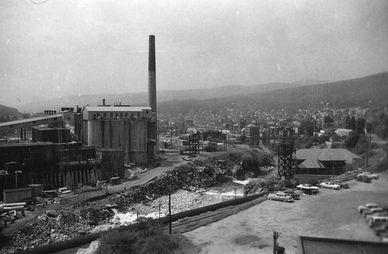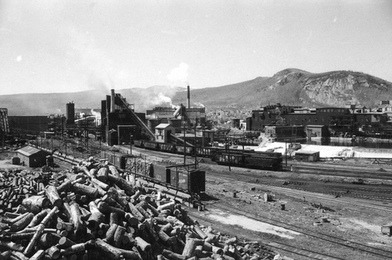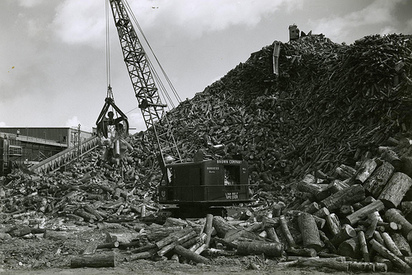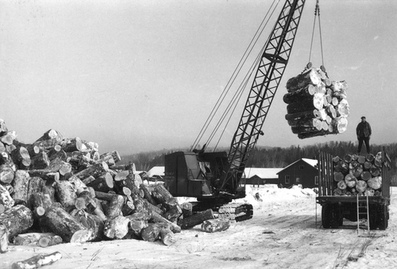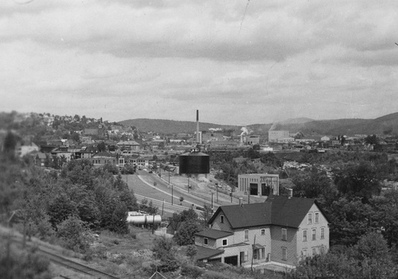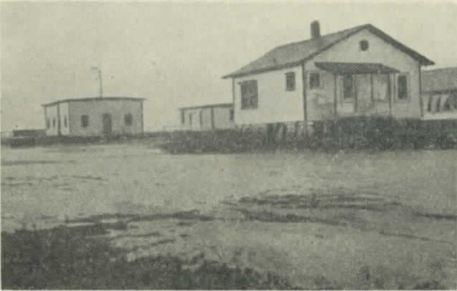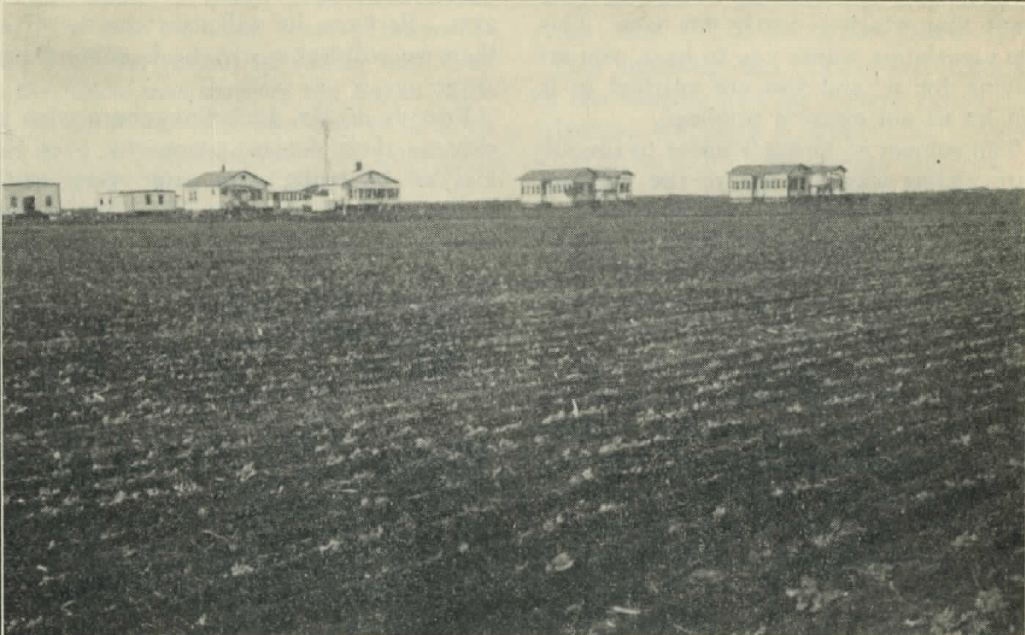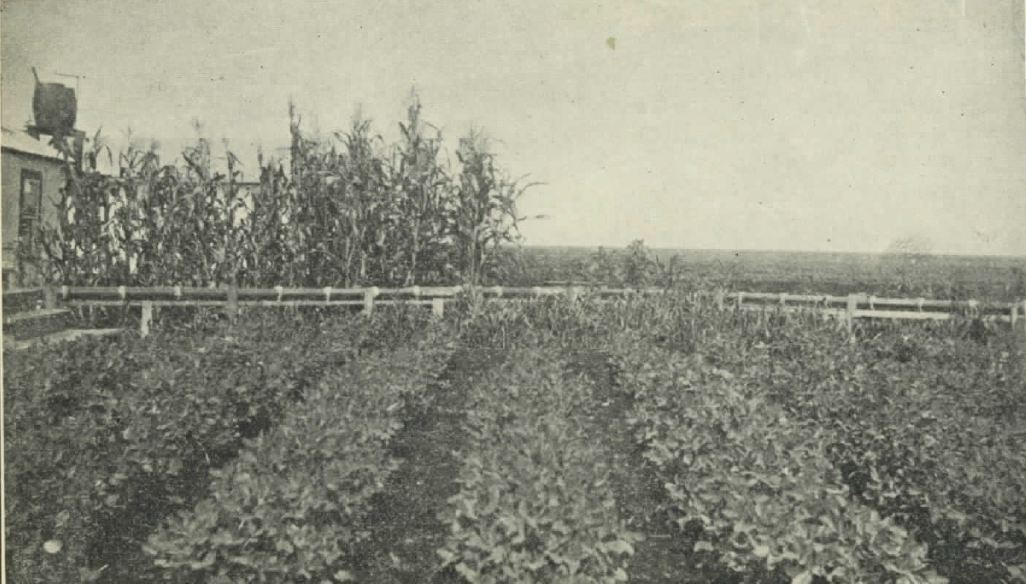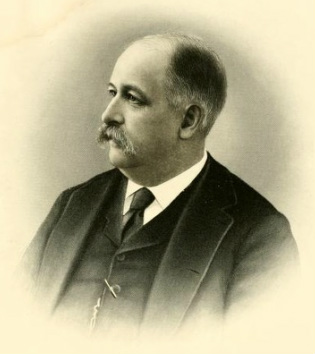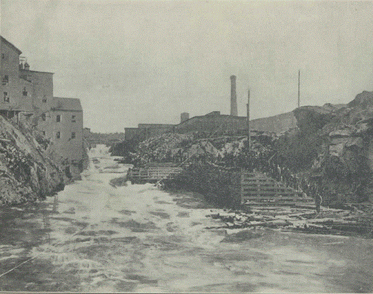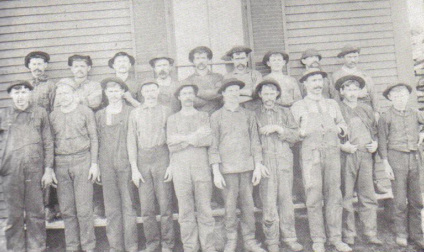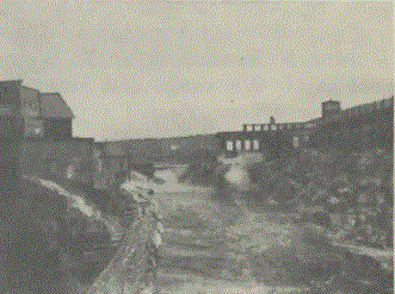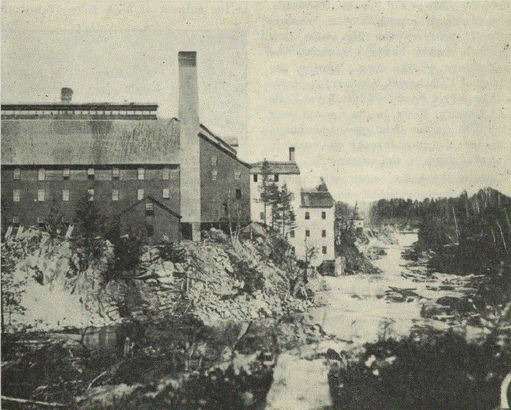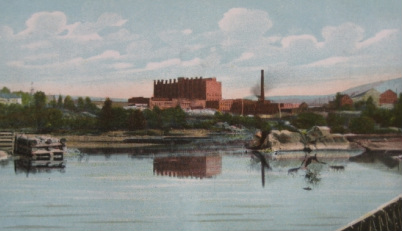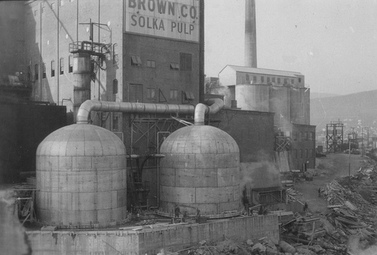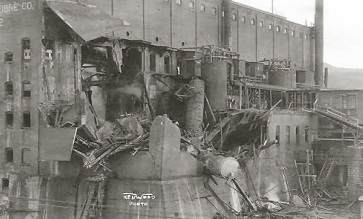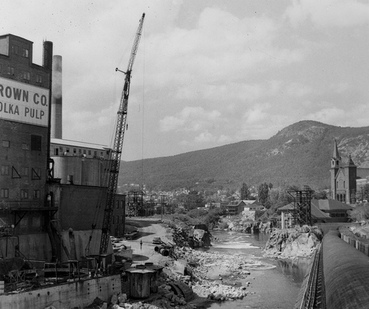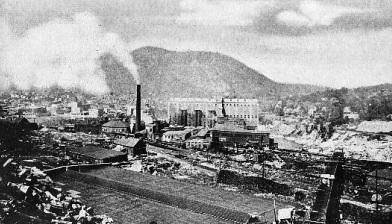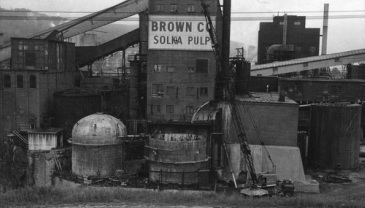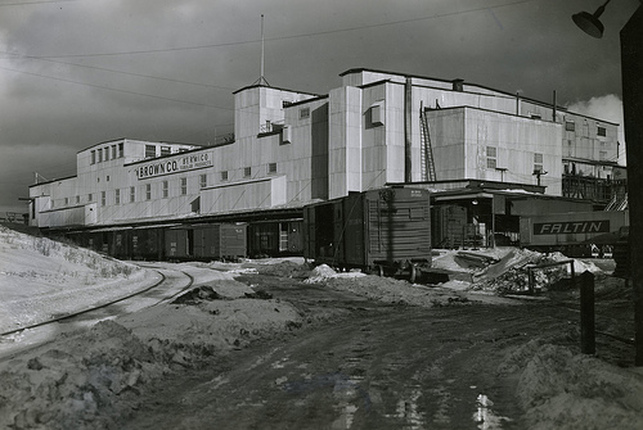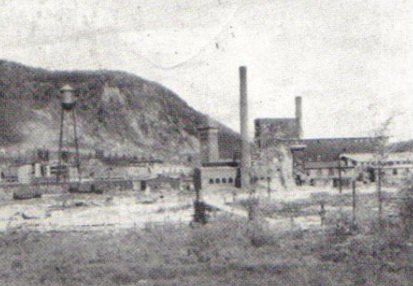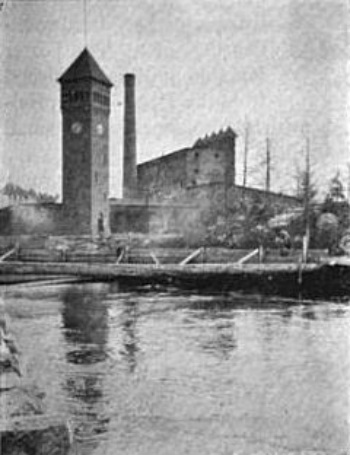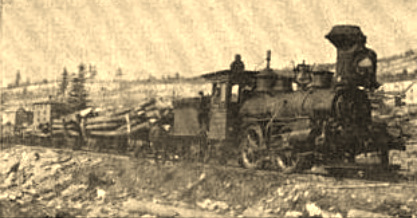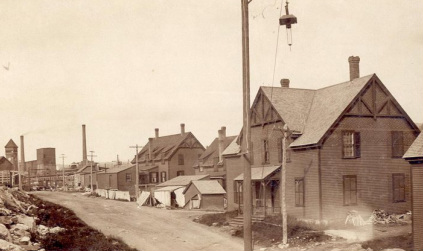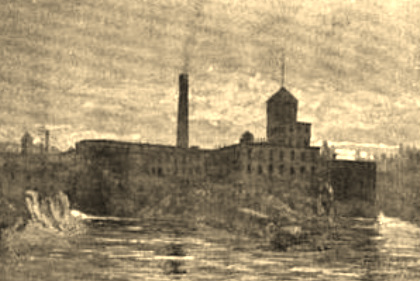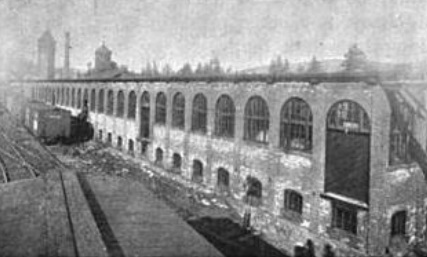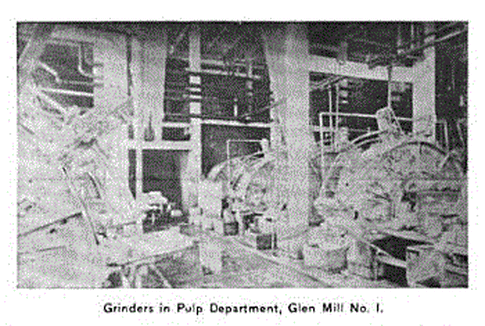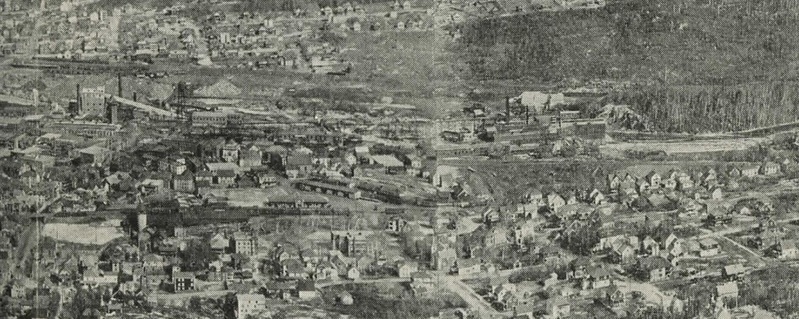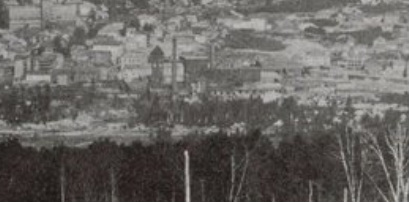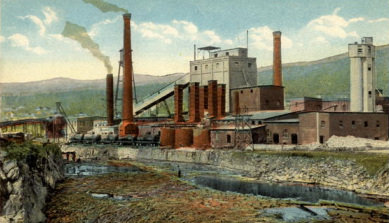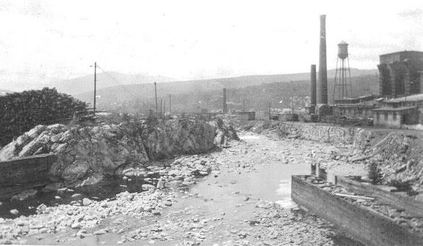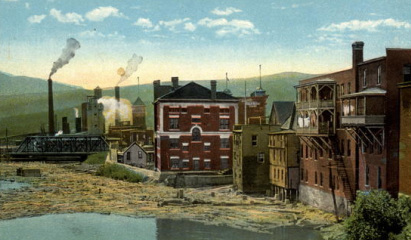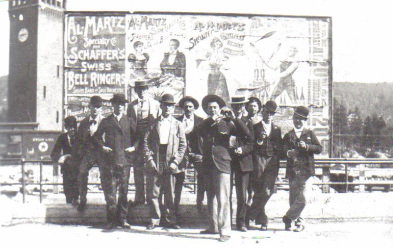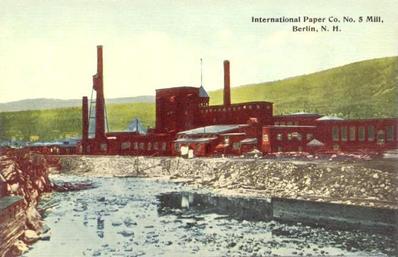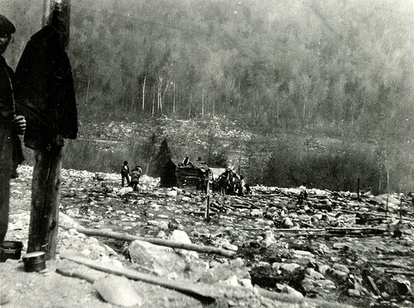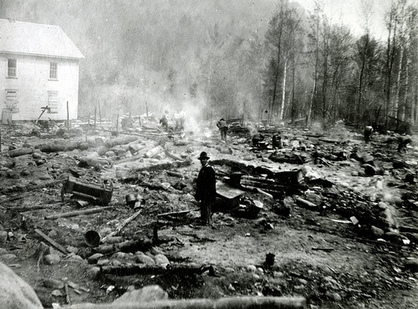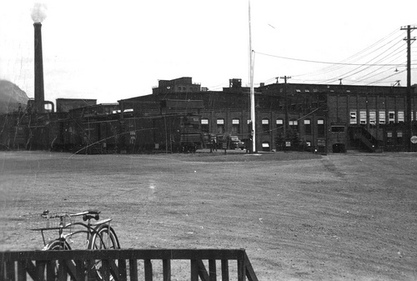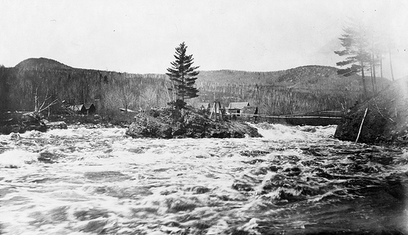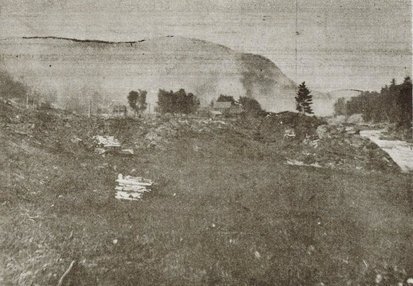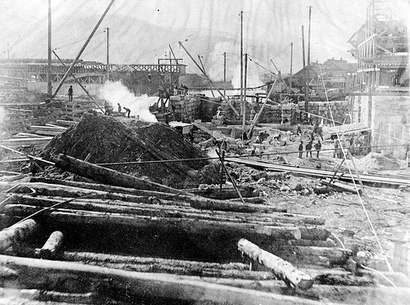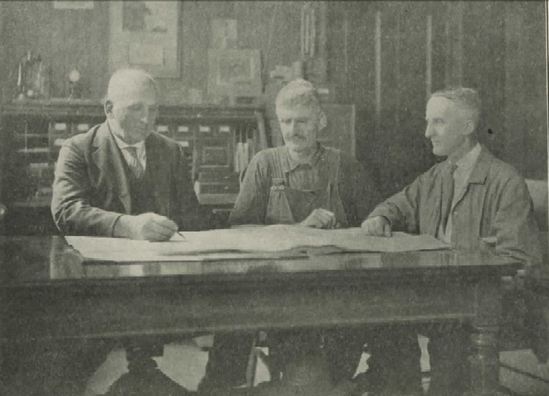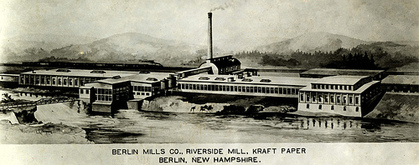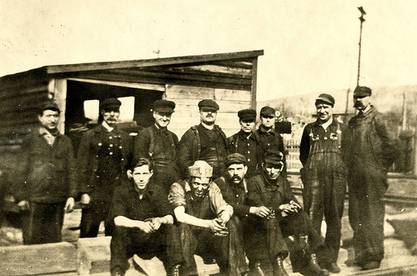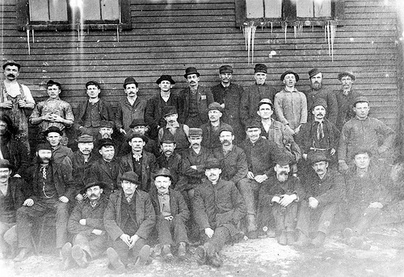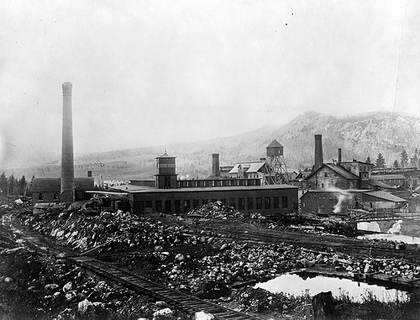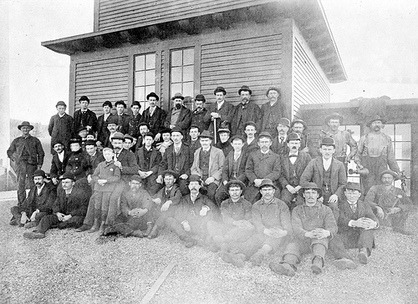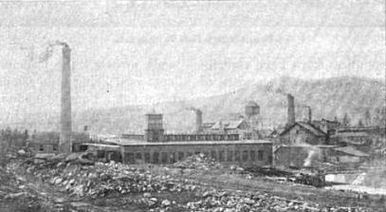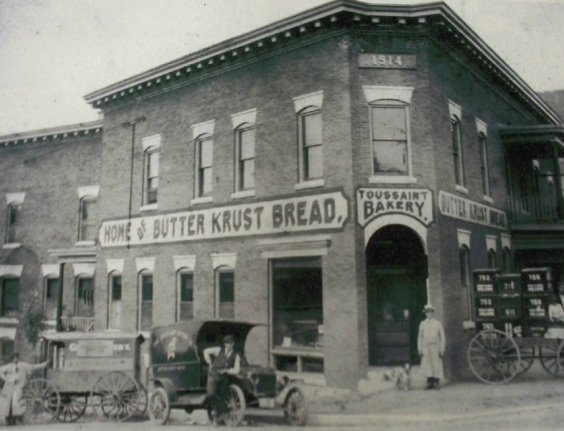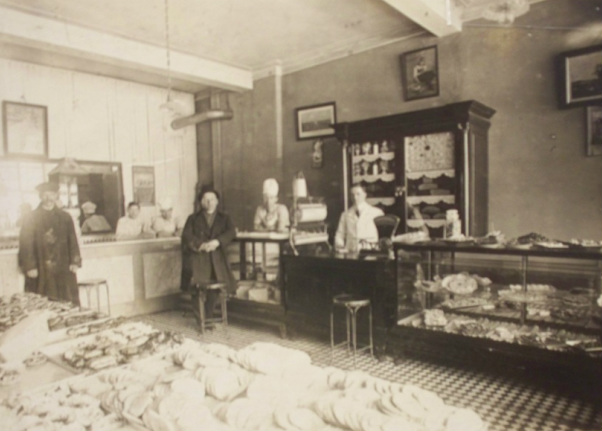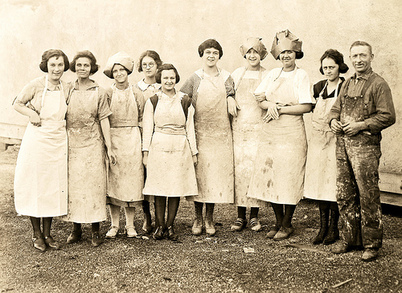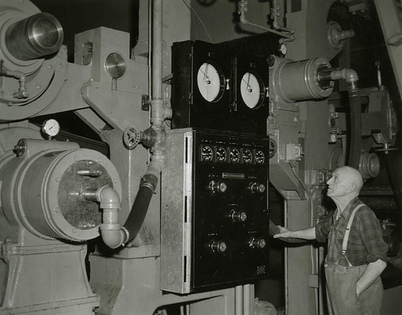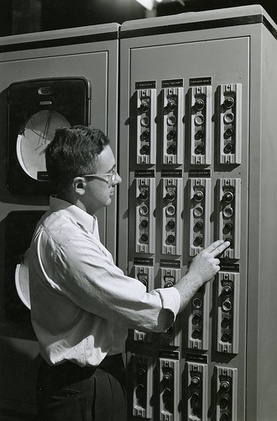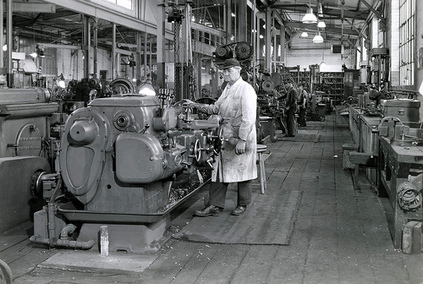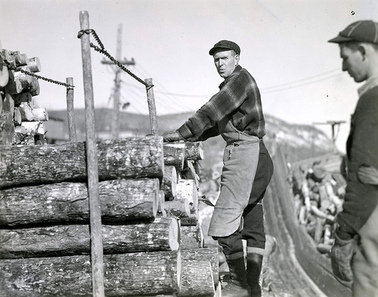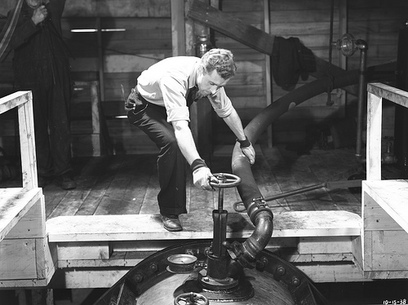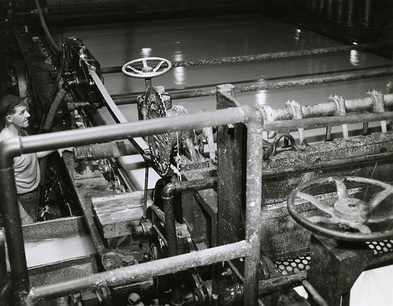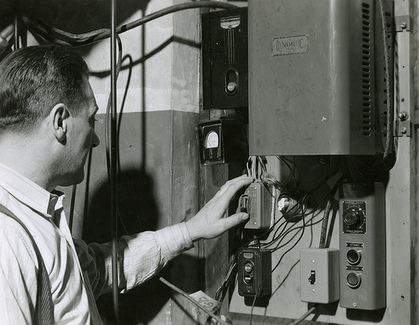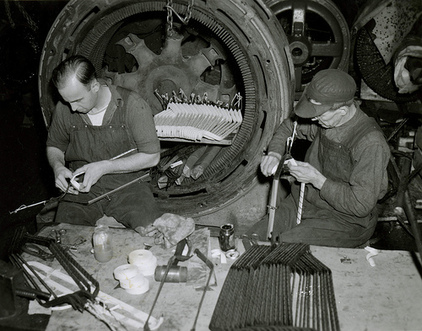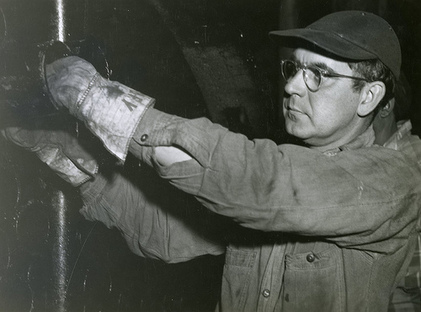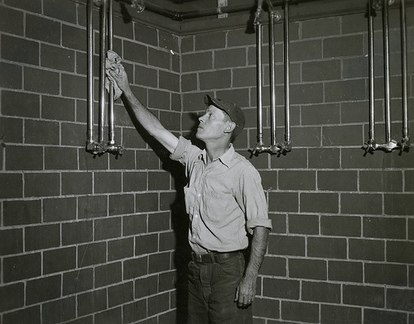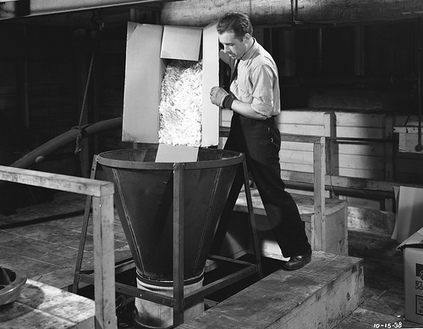Industry of Berlin New Hampshire
The Dead River Lumbering Company
The Dead River Lumbering Company was the first corporation in Berlin. It was started in 1830 by James Osgood, Lot Davis, and Samuel McDonal.
H. Winslow & Company/Berlin Mills Company
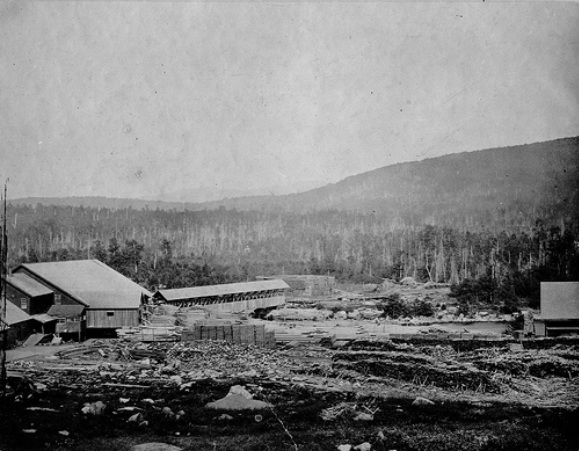
A photo taken in 1870 of the Berlin Mills Company Sawmill
1852, a group of Portland, Maine businessmen, John B. Brown, Josiah S. Little, Nathan Winslow, and Hezekiah Winslow, a former sea captain, bought land to built a small sawmill and dam on the same site where, in 1826, Thomas Green of Shelburne tried to build his sawmill but failed do to a storm. This area of land was known as the “Thomas Green Privilege”. The Hezekiah Winslow and Company’s Sawmill, also known simply as H. Winslow and Company, contained one gang and two single saws with a maximum daily capacity of about 25,000 feet of long lumber. In 1853, the company built the first part of their Company Store (later called Brown Company Store) and a large boarding house, now known as the Brown Company House.
In 1854, the H. Winslow and Company branch railroad was constructed to the Grand Trunk. In 1855, a second gang saw was added and, in 1858, another single saw and a gristmill with three runs of stones were installed. The first rotary saw came in 1860. The name “Berlin Mills Company” dates to 1866, when it was adopted by a partnership consisting of John B. Brown, Mrs. J. S. Little, and Messrs. Clement, Brigham, and Warren. Mr. John Little had died, and the Winslows had sold their interests. In 1868, William Wentworth Brown and Lewis T. Brown purchased the interest of John B. Brown in the Berlin Mills Company. By 1875 production had developed to such an extent that every morning a special train of 22 cars of lumber left Berlin for teams of four horses each were used
In the 1880’s the sawmill was remodeled and was the most productive sawmill on this side of Michigan. Shortly before 1890, it became evident that the expense of the horses would more than pay upkeep and interest charges on a locomotive. A locomotive was first borrowed from the Glen mill as an experiment. It proved too light and in 1890 the company purchased Engine No. 1, weighing 24 tons.
The company could not depend entirely upon the Grand Trunk for its switching and used oxen to move cars about the yard. These were stabled near Burke's mill and "Gee, Brad" and "Haw, Star" was then a vigorous part of the Yankee language. Then, too, for some transfer work special dummy lines grew up. These had wooden rails with iron straps and cars carrying about a cord of wood. One line led across a wooden bridge to a kiln near the chemical mill, where edgings were burned to recover the potash.
The oxen had their day and were replaced by horses and occasional mules. For shifting standard size cars, string from the Grand Trunk to run No. 1. Workers received $2.00 a day for working eleven hours. No. 1 was a wood burner and had a huge cinder catcher on the smoke stack. No. 1 was finally scrapped in Portland, where she was sent for repairs about 1900 and her boiler was found unsound. In 1892, it was decided to buy a second locomotive, the result was Engine No. 2, weighing 30 tons. She was finally scrapped by the salvage crew around 1919 or 1920, and Engine No. 3 in 1893.
On July 11, 1897, the original sawmill burnt down and a new one built with the capacity of 200,000 feet of long lumber. There was another fire in 1913 and a concrete plant was built. Today on the site of these old sawmills sits the Northern Forest Heritage Park, which is a replica of a early 1900’s logging camp.
In 1854, the H. Winslow and Company branch railroad was constructed to the Grand Trunk. In 1855, a second gang saw was added and, in 1858, another single saw and a gristmill with three runs of stones were installed. The first rotary saw came in 1860. The name “Berlin Mills Company” dates to 1866, when it was adopted by a partnership consisting of John B. Brown, Mrs. J. S. Little, and Messrs. Clement, Brigham, and Warren. Mr. John Little had died, and the Winslows had sold their interests. In 1868, William Wentworth Brown and Lewis T. Brown purchased the interest of John B. Brown in the Berlin Mills Company. By 1875 production had developed to such an extent that every morning a special train of 22 cars of lumber left Berlin for teams of four horses each were used
In the 1880’s the sawmill was remodeled and was the most productive sawmill on this side of Michigan. Shortly before 1890, it became evident that the expense of the horses would more than pay upkeep and interest charges on a locomotive. A locomotive was first borrowed from the Glen mill as an experiment. It proved too light and in 1890 the company purchased Engine No. 1, weighing 24 tons.
The company could not depend entirely upon the Grand Trunk for its switching and used oxen to move cars about the yard. These were stabled near Burke's mill and "Gee, Brad" and "Haw, Star" was then a vigorous part of the Yankee language. Then, too, for some transfer work special dummy lines grew up. These had wooden rails with iron straps and cars carrying about a cord of wood. One line led across a wooden bridge to a kiln near the chemical mill, where edgings were burned to recover the potash.
The oxen had their day and were replaced by horses and occasional mules. For shifting standard size cars, string from the Grand Trunk to run No. 1. Workers received $2.00 a day for working eleven hours. No. 1 was a wood burner and had a huge cinder catcher on the smoke stack. No. 1 was finally scrapped in Portland, where she was sent for repairs about 1900 and her boiler was found unsound. In 1892, it was decided to buy a second locomotive, the result was Engine No. 2, weighing 30 tons. She was finally scrapped by the salvage crew around 1919 or 1920, and Engine No. 3 in 1893.
On July 11, 1897, the original sawmill burnt down and a new one built with the capacity of 200,000 feet of long lumber. There was another fire in 1913 and a concrete plant was built. Today on the site of these old sawmills sits the Northern Forest Heritage Park, which is a replica of a early 1900’s logging camp.
A Closer Look At The Sawmill
StorehouseSawmill |
GristmillBridge |
Burgess Biopower
Berlin's First Logging Camp
Berlin’s first logging camp was built by Thomas Lary and Thomas Green on the east-side in 1824 or 1825 near the where the walking Bridge is today. In, 1826, Thomas Green also erected the first sawmill but was not successful.
The Brown Company
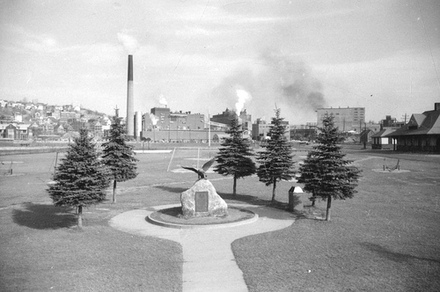
The mill with the Spanish American War memorial in front (Image from Beyond Brown Paper archives)
In the 1880s W. W. Brown purchased the remaining stock and acquired complete control of the Berlin Mills Company. By the early twentieth century the Berlin Mills Company changed its name during World War I to the Brown Company because the war in Germany. Unlike the International Paper Company, the Brown Company appeared to have avoided economic disaster in the early 1930s but in the 1940’s that all went downhill. The Brown family lost its remaining interest in Brown Company and the mill was sold to outside investors. The mills continued to decline under a series of out-of-state corporate owners, until the last owner, Fraser Paper, finally closed the Berlin pulp mill in 2006.
The Forest Fibre Company
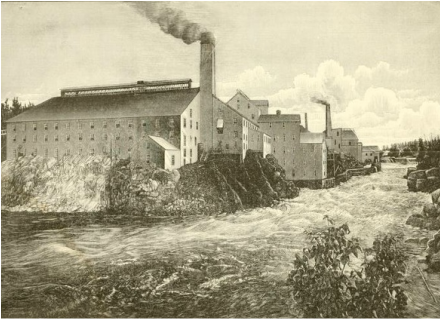
A postcard of the Forest Fibre Company (Image from Poof Tardiff)
The Forest Fibre Company was one of the first industries in Berlin. They erected the first mill, Mill A, in July of 1877 and the second, Mill B, in 1880. The Forest Fibre Company was Berlin’s first chemical pulp mill. It was managed and owned by Henry H. Furbish, who had spent many years experimenting with the idea of making paper from wood. In 1870 he started his work in Pennsylvania and eventually made a formula. In 1878 Mr. Furbish was an expert in subject and moved to Berlin. As the mills expanded, they made up to five tons of pulp per day. When Mill B was built they ultimately had a production of twenty-five tons a day, such was considered to be a large amount under conditions in America at that time. Soda pulp from poplar trees was proved to have serious limitations as compared with sulphite pulp, and the mill closed its operations in the early 1890’s after a fire that destroyed most of this mill.
The White Mountain Pulp and Paper Company
In September of 1883, P.W. Locke purchased land near where the Dead River met the Androscoggin River from Daniel Green. Mr. Locke built a three-ton pulp mill. In December of 1883, the White Mountain Pulp and Paper Company was organized with a capital of $40,000. With B.S. Gibson as president, P.W. Locke as treasurer, and A.M. Munce as clerk this company doubled its capacity. In 1885, they also purchased additional power sufficient in running there company. In 1886, Additions were made and the production grew to seven tons a day, and making 30 jobs. This building was one of the first mills to be lighted through the night by forty-one of Edison’s incandescent electric lights. By the end of 1886, Mr. Locke sold his share in this company to Benjamin F. Hosford and a year later in 1887 this mill was bought by the Glen Manufacturing Company. This mill was the second mill built in Berlin and sat on almost the exacted same spot as today’s (2011) SaVoir Flare on Main Street.
The Burgess Sulphite Fibre Company
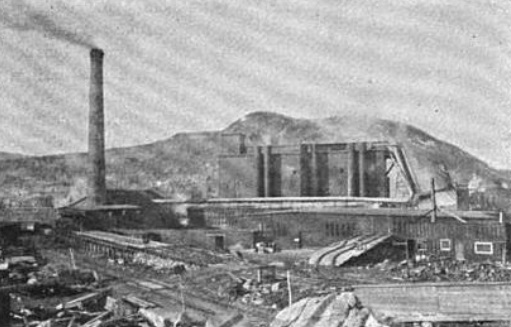
The Burgess Sulphite Fibre Company from the east side
The Burgess Sulphite Fibre Company was built in the 1892 by the Brown Company. It was on the eastside of the Androsscoggin River. The most famous superintend of this plant was George E. Burgess. Mr. Burgess was known for his kind hart and helped this city out a lot and he was also a graduate of Harvard University. The plant started off very small but soon took off and produced up to 250 tons a day in 1902. On August 19, 1902 Mr. Burgess passed away and was succeed by E.E. Decker. Other personal of this plant in 1902 included William Wentworth Brown as president, and T.P. Burgess as general manager and treasurer. This plant closed in 1963. (Image from the Granite State Magazine of 1896)
The Bermico Plant
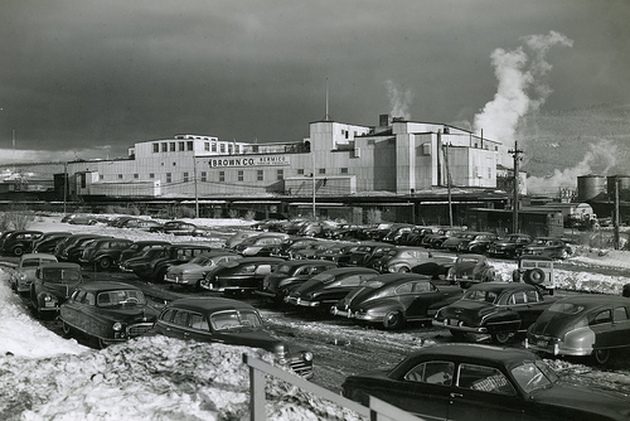
Bermico Plant
During World War I, there was a great need for guns and bullets to fight the war in Europe. The Berlin Mills Company recognized this and began producing powder containers for six-inch guns. Around the same time the Berlin Mills Company became the Brown Company, due to the war against Germany. The Brown Co. decided to name this new department Bermico after the old name of this company. By the mid 1920’s, Bermico went into the production of drainage pipes for coal mines. The late 1920’s saw the Bermico fiber pipe, which was sold all around the world. By the end of World War II, the famous Bermico sewer pipe was added to the Bermico line. The Bermico plants reached its peak when of over 300 people were imploded in the 1950’s. The decline of Bermico in Berlin was due to the opening of Bermico plants in Corvallis, Oregon in 1956, Birmingham, Alabama in 1960, and Mt. Holly, New Jersey in 1962. In January of 1964, the Brown Company announced that the Bermico plant in Berlin would close down permanently on April 1, 1964, which it did. Bermico fiber pipes and sewer pipes were produced at the other Bermico plants until the closure of the Brown Company in the late 1970’s.
The Glen Manufacturing Company
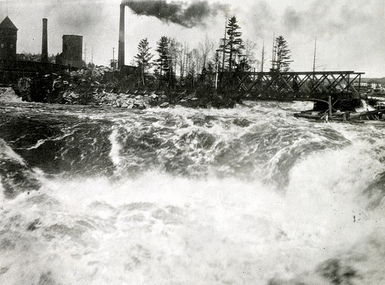
The Berlin Falls at the Glen Mill (Image from Beyond Brown Paper archives)
The Glen Manufacturing Company came to Berlin in 1885 and purchased the privilege locally known as the “Great Pitch” privilege of Daniel Green. They built their first mill which the town voted to exempt from taxation for a term of ten years. The company steadily increased their plant until they were said to have the largest newspaper plant in the world. Their first paper machine was running in the spring of 1886 and was named after Col. C. H. Taylor, of the Boston Globe. In 1887 they made an addition to their first mill, giving them three paper machines. In the same year they purchased a mill which had been operated for a short time by the White Mountain Pulp and Paper Co., which they incorporated with their mill No. 5. No. 3 was erected in 1889. They made more than 125 tons of paper per day, using more than 30,000,000 feet of spruce timber per annum. They owned about 100,000 acres of timber lands and contracts for the cutting of their own timber so that their facilities for obtaining their raw material were unequaled by any other large paper mills in the country and for this reason they were able to manufacture at an advantage over those less favorably situated. They made about fifty tons of sulphite pulp per day. Pulp soaked in water and a certain percentage of sulphite added there to is then passed through the paper machine, a great mass of machinery in which the moist pulp passing over felts and screens and between warm cylinders and over various appliances for drying out the water, finally comes out at the other end of the machine in the form of a wide sheet of pure white paper, ten feet wide, on the largest machine in the Glen mills and is wound up in a great roll ready for the printing press, at the rate of about three hundred feet per minute. The Glen paper machines probably turn out nearly one hundred thousand square feet of newspaper every minute and they ran day and night continuously, twenty-four hours a day and seven days in a week. They had continuous contracts with the Boston Globe and the New York Tribune and their paper was used in newspaper offices from Maine to Texas, and in the British Isles. Their payroll was about $6,000 and they give employment to five hundred men. They were directly connected with both the Boston & Maine and Grand Trunk railroads, by their own railroad tracks, and they had in constant use three locomotives of their own by which all the shifting of the cars was done around their mill yard. They had also erected many cottage houses which were rented to their employees making what is locally known as “Glen Village,” and in countless ways they have contributed directly and indirectly to the prosperity of this town.
International Paper Company
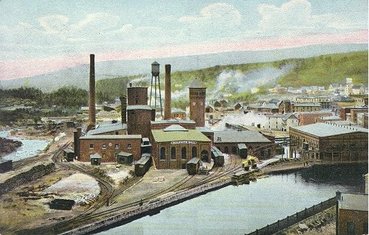
The I.P. Mill (Image from Poof Tardiff)
In 1898 the Glen Manufacturing Company was bought out by the International Paper Mill. In 1931, The International Paper Company responded to a labor strike by closing its local mill, leaving many men unemployed with little hope of obtaining other employment because of the great depression.
Tragic Death of a Young Immigrant in the International Paper Mill
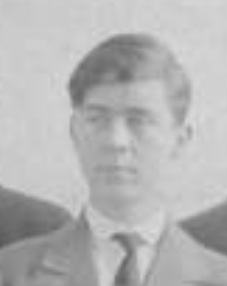
Herménégilde Rousseau
In the year 1907 there was a tragic death of a young French Canadian immigrant in the mills of the International Paper. The man was named Herménégilde Rousseau and was from St. Apollinaire, Canada. Mr. Rousseau was working in the wood department of Mill C when tragedy struck. Around ten thirty to eleven o’clock in the morning, Mr. Rousseau was putting a belt onto a machine. He got caught up in the shafting and thrown around. His head, hands, and legs were all detached from his body. At the end Mr. Rousseau lost his life and it left one eyewitness horrified. This very incident happened many times in the mills of Berlin to people of all ages. (Image from www.gsavard.home.comcast.net)
The Cascade Mill
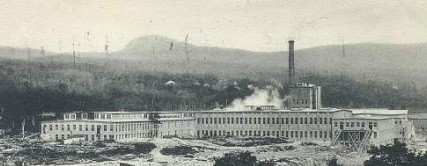
The Cascade Mill (Image from Beyond Brown Paper archives)
Construction of the Cascade Mill was started in August of 1902, although plans for the mill were made months before. The site of the mill utilized both the Cascade Falls privilege and the Cross and Smith privilege. Houses on the site were purchased and torn down. The mill was completed in 1903. At first the mill had only three or four paper machines, each of large capacities. The current (2013) owners acquired the property in May of 2011 from Fraser Papers via investment funds. Today, the mill is run under the name “Gorham Paper and Tissue” and is the last historic paper mill in Coos County.
.
.
|
|
|
The Riverside Pulp Mill
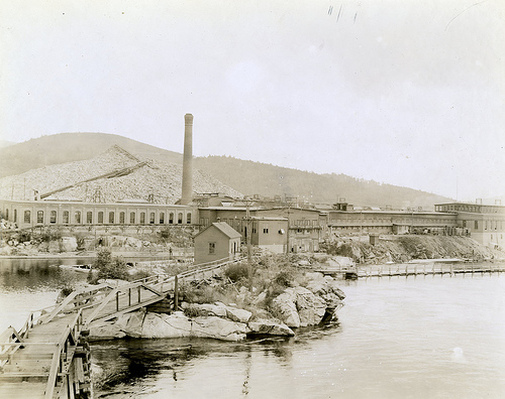
The Riverside Mill in the year 1914 (Image from Beyond Brown Paper archives)
The Berlin Mills Company wanted to expand its business. In 1888 they built the Riverside Pulp Mill. This mill had a capacity of 30,000 pounds daily. It was situated behind today’s (2011) new courthouse on the other side of the river.
|
|
The Berlin Shoe factory
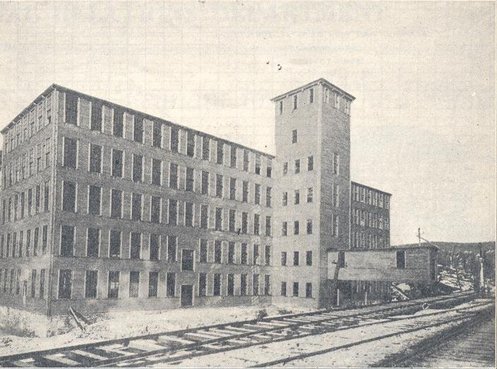
The Berlin Shoe Factory (Image from Poof Tardiff)
The Berlin Shoe factory (also known as the Chick Brothers Shoe Company) was commenced in 1895. When completed, the building was 200 feet by 50 feet and stood five stories high. It was situated on the side of the tracks of the Grand Trunk, just before the Green Street trestle.
It operated just over three years and at one point employed more than 500 people, to include for the first time, many local women who wanted to work. Today, the same spot near the Berlin Police station, where this building once stood, is where kids play soccer in the summer and fall and skate in the winter.
It operated just over three years and at one point employed more than 500 people, to include for the first time, many local women who wanted to work. Today, the same spot near the Berlin Police station, where this building once stood, is where kids play soccer in the summer and fall and skate in the winter.
The Berlin Foundry and Machine Company

The Berlin Foundry and Machine Company on Goebel Street in the year 1904 (Image from Poof Tardiff)
George Harkins and John Mahern came to Berlin in the year 1900 and started a business. At first they operated out of a one story building but in 1904 it was decided that they were to build a new two-story building. The first story would be the machine shop and the second would be the working department. The name was also changed from the Berlin Iron and Brass Foundry to the Berlin Foundry and Machine Company. This business still operates today (2011) on Goebel Street.
The Cross Machine Shop

The first Cross Machine Shop owned by E.M. Cross (Image from Poof Tardiff)
The first Cross Machine Shop was owned by Mr. E.M. Cross and was on Glen Ave. somewhere around the area of today’s Cross Machine Shop. On June 2, 1904 an alarm was sounded shortly after eight o’clock in the evening. When fireman arrived the whole building was in flames because it was only a one story wooden structure. The loss was estimated at $5,000 which was a lot back in 1904. Mr. Cross built a temporary building shortly after the fire and resumed castings by the latter part of the week.
The Toussaint Bakery
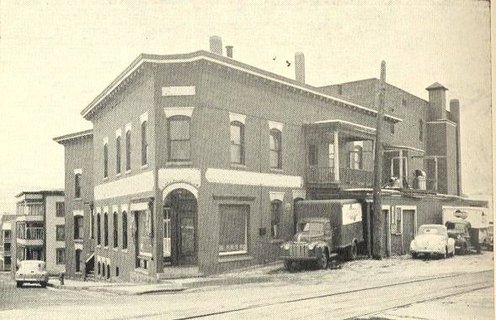
The Toussanint Bakery (Image from Poof Tardiff)
The Toussaint Bakery was the idea of Mr. Edouard Toussaint who came to Berlin in 1881. He worked for the Furbish Mill for a few years and was successful in the lumbering business under the name of “Guay and Toussaint”. Edouard Toussaint got into the bakery business in 1888, having started the “Toussaint Baking Company” just below his huge bakery which was built in 1914. The Toussaint Bakery was called home of the “Butter Krust Bread” and was producing over 45 thousand loaves of bread a week.
The Star Bakery
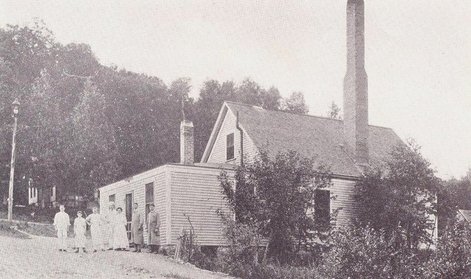
The Star Bakery (Image from Poof Tardiff)
The Star Bakery was situated on the corner of Seventh and Denmark Street. There is an empty lot there today. The bakery was started by G. Gunnerson in 1907. From a small beginning, Mr. Gunnerson built a large and flourishing business, calling his product “Starcream Bread”. When his business was at its peak, ten people were employed here. His product was shipped to all sections of the city and further. Modern wax paper was used to ensure the freshness of his product.Bottom of Form
Berlin Manufacturing Company
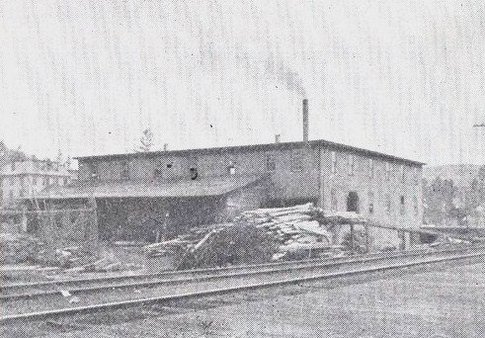
Berlin Manufacturing Company (image from Poof Tardiff)
The Berlin Manufacturing Company was organized in June of 1892. The purpose of this company was to manufacture lumber products, such as making cabinets and other general carpentry jobs. When this company got started, the elected officers were A.K. Cole (president), J. Howard Wight, A.H. Eastman, George W. Page, A.H. Gerrish, Lyman Cole, and L.D. Yates, all of these men were once active business men in Berlin. This Company had a sawmill, planers, and a first-class kiln for both soft and hardwood. What helped this company flourish was that this mill was located directly behind the Grand Trunk Station on the West-side, so they could easily ship their products anywhere around New England in a matter of days. The Berlin Aqueduct Company placed a fire hydrant near the mill to protect it from fire, but it seems like nothing can stop natures furry.
On September 19, 1896, a fire broke out in this building. The weather was rainy with very little wind. The fire department made a huge mistake by putting too many streams on one main and poor water pressure from the fire hydrant was the result. This company could not beat fire and, as a result, burned to the ground.
On September 19, 1896, a fire broke out in this building. The weather was rainy with very little wind. The fire department made a huge mistake by putting too many streams on one main and poor water pressure from the fire hydrant was the result. This company could not beat fire and, as a result, burned to the ground.
